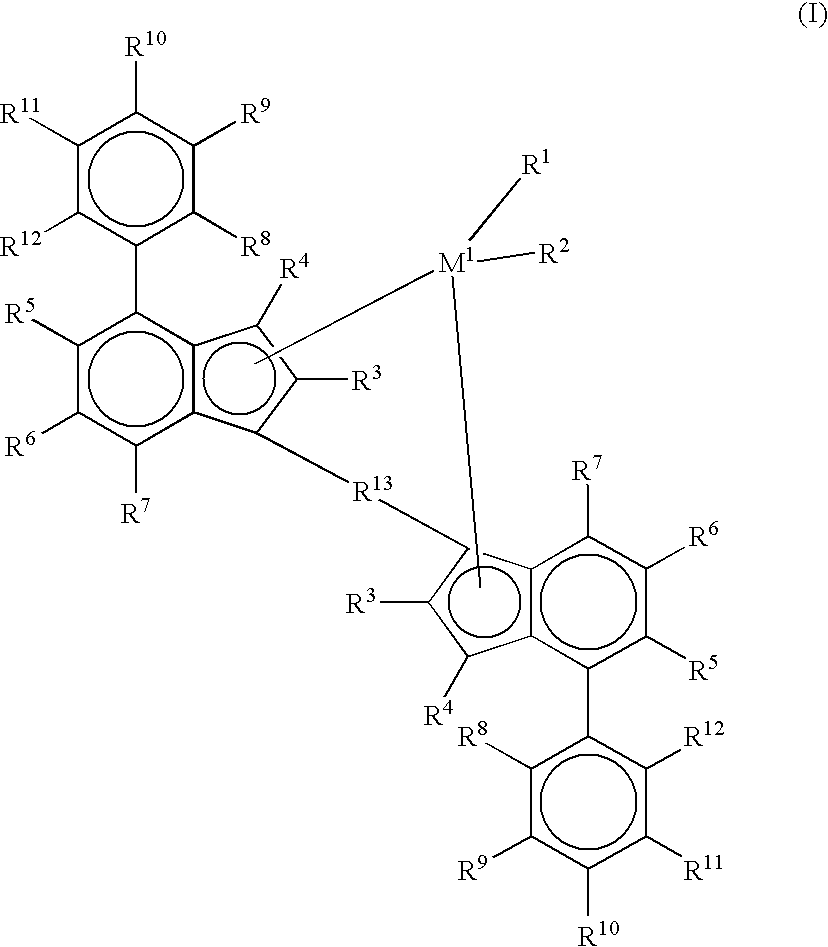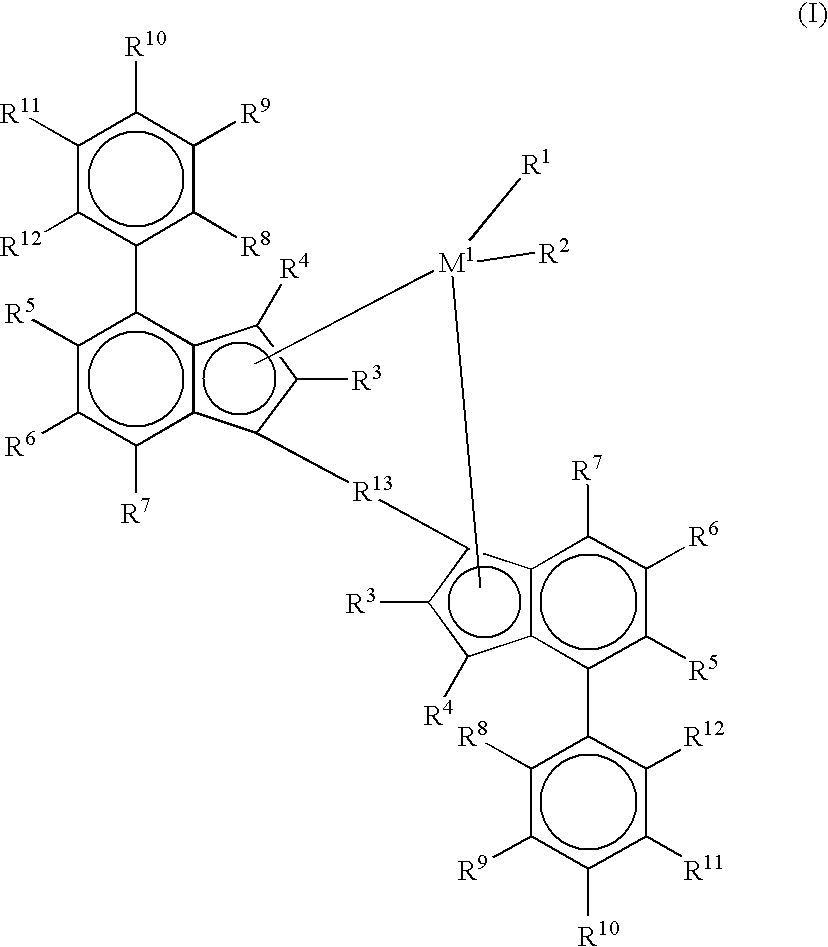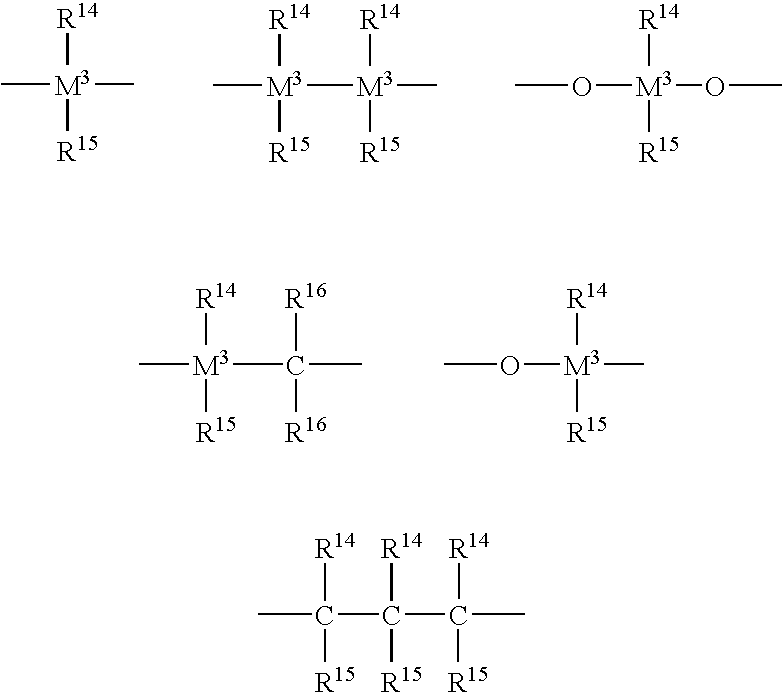Metallocenes and catalyst compositions derived therefrom
a technology of metalocene and catalyst, applied in the field of metalocene compounds, can solve the problem of lower melting point of polymer, and achieve the effect of high molecular weight and high melting poin
- Summary
- Abstract
- Description
- Claims
- Application Information
AI Technical Summary
Benefits of technology
Problems solved by technology
Method used
Image
Examples
example 1
[2517]Racemic dimethylsilanediylbis{1-[2-methyl, 4-phenylindenyl]}zirconium dichloride was obtained from commercial sources and used as received.
Supported Metallocene Catalyst System 1
[2518]In a 100 mL round bottom flask racemic dimethylsilanediylbis{1-[2-methyl, 4-phenylindenyl]}zirconium dichloride (0.055 g) was added to the above MAO solution (6.74 g, 7.2 mL) and stirred twenty minutes. The resultant mixture was filtered through a medium glass frit funnel and washed with toluene (14 mL). To the combined filtrates was added dehydrated silica (4.0 g, Davison 948 Regular, 600° C. dehydration). This slurry was stirred for twenty minutes then dried at 40° C. for two minutes under vacuum on a rotary evaporator until the liquid evaporated and then the solid was further dried a total of about 2 hours and twenty two minutes. The supported catalyst was recovered as a light orange, free flowing solid (5.63 g).
example 2
2-Methyl, 4-(3-methylphenyl)-indene
[2519]3-Bromotoluene (10.0 g, 58 mmol) and magnesium turnings (2.0 g, 83 mmol) were taken up in 150 mL of Et2O (diethyl ether) and stirred at room temperature overnight to form the Grignard solution. In a separate flask, NiCl2(PPh3)2 (1.8 g, 2.8 mmol) and 4-chloro-2-methylindene (9.5 g, 58 mmol) were dissolved in 150 mL of Et2O. The Grignard solution was added dropwise to this solution and allowed to stir overnight at reflux. After overnight stirring, the reaction was slowly quenched with H2O to neutralize unreacted Grignard. The solution was subsequently treated with 100 mL of 10% HCl(aq), and neutralized with saturated sodium bicarbonate aqueous solution. The organic layer was dried with magnesium sulfate and the solvent removed by rotary evaporation. The remaining residue was loaded onto a silica gel column and eluted with hexane. Yield: 6.3 g (48%).
Lithium{1-[2-methyl, 4-(3-methylphenyl)indenide]}
[2520]2-Methyl, 4-(3-methylphenyl)-indene (6.3 g...
example 3
2-Methyl, 4-(3,5-dimethylphenyl)-indene
[2524]4-Chloro-2-methylindene (8.9 g, 54 mmol) and NiCl2(PPh3)2 (1.8 g, 2.8 mmol) were dissolved in 150 mL of Et2O. 3,5-Dimethylphenylmagnesium bromide (10 g, 54 mmol) as Et2O solution was added to the solution and the reaction was stirred overnight at room temperature. After overnight stirring the reaction was slowly quenched with H2O to neutralize unreacted Grignard. The solution was subsequently treated with 100 mL of 10% HCl(aq), and neutralized with saturated sodium bicarbonate aqueous solution. The organic layer was dried with magnesium sulfate and the solvent was removed by rotary evaporation. The remaining residue was loaded onto a silica gel column and eluted with hexane. Yield: 5.6 g (44%).
Lithium{1-[2-methyl, 4-(3,5-dimethylphenyl)indenide]}
[2525]2-Methyl, 4-(3,5-dimethylphenyl)-indene (5.6 g, 23.9 mmol) was dissolved in 80 mL of pentane. To this solution was added 9.6 mL of n-BuLi (2.5M in hexane) and the reaction was allowed to sti...
PUM
| Property | Measurement | Unit |
|---|---|---|
| particle size | aaaaa | aaaaa |
| pressure | aaaaa | aaaaa |
| temperature | aaaaa | aaaaa |
Abstract
Description
Claims
Application Information
 Login to View More
Login to View More - R&D
- Intellectual Property
- Life Sciences
- Materials
- Tech Scout
- Unparalleled Data Quality
- Higher Quality Content
- 60% Fewer Hallucinations
Browse by: Latest US Patents, China's latest patents, Technical Efficacy Thesaurus, Application Domain, Technology Topic, Popular Technical Reports.
© 2025 PatSnap. All rights reserved.Legal|Privacy policy|Modern Slavery Act Transparency Statement|Sitemap|About US| Contact US: help@patsnap.com



